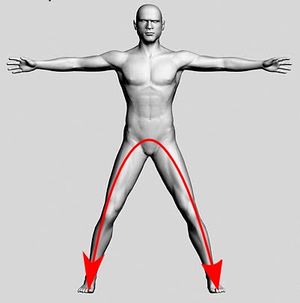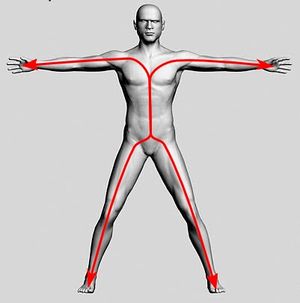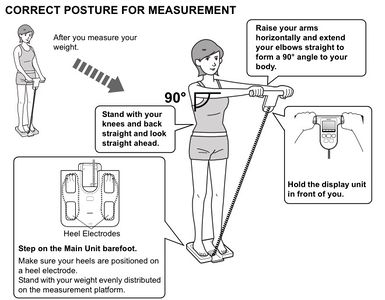Difference between revisions of "Body Fat Scales"
User:Fellrnr (User talk:Fellrnr | contribs) m (→Recommended scales – Omron HBF-510) |
User:Fellrnr (User talk:Fellrnr | contribs) |
||
| Line 1: | Line 1: | ||
| − | + | The right body fat scales can provide a cost-effective and convenient way of measuring body fat. The right body fat scales are ones which measure from both the hands and feet, rather than from either the feet or hands alone. | |
| − | The right body fat scales can provide a cost-effective and convenient way of measuring body fat. The right body fat scales are ones which measure from the hands and feet, rather than the feet alone. | + | =How They Work= |
| − | + | Bioelectrical Impedance Analysis (BIA) scales use an imperceptible electrical signal to calculate the amount of water in the body and thus estimate body fat. BIA compares the electrical resistance of a direct current to an alternating current. The direct current does not penetrate the cell walls whereas the alternating current does. This creates a difference that allows an estimate of extracellular water. | |
| − | =How | + | ==Two or Four Electrodes== |
| − | + | BIA scales either have two electrodes that measure from the feet, or four electrodes that measure from both the hands and the feet. You can see in the images below the path electricity takes with scales that measure via feet only compared with when measurements are from the hands and feet. I would not recommend any BIA scales that measure from the feet only. There are also [http://www.amazon.com/Omron-Logic-Monitor-HBF-306C-Silver/dp/B00006WNPU BIA devices that measure from the arms only], but these suffer from similar problems. | |
| − | [[File:Human Figure Lower.jpg|none|thumb|300px|The path taken by body fat scales that only measure between the feet.]] | + | {| class="wikitable" |
| − | + | |- valign="top" | |
| − | [[File:Human Figure Full.jpg|none|thumb|300px|The path taken by body fat scales that measure from the hands and feet.]] | + | |[[File:Human Figure Lower.jpg|none|thumb|300px|The path taken by body fat scales that only measure between the feet.]] |
| − | + | |[[File:Human Figure Full.jpg|none|thumb|300px|The path taken by body fat scales that measure from the hands and feet.]] | |
| − | = | + | |} |
| − | + | ==Single or Dual Frequency== | |
| − | + | Typically the alternating current is around 50 kHz, with dual frequency scales adding in 6.25 kHz for improved accuracy. Single frequency scales generally treat the body is a single cylinder with uniform resistance. Unfortunately because the arms and legs are thinner than the trunk they contributed disproportionate amount of resistance. Typically arms and legs are about 5 to 20% of body weight, but form about half of the overall resistance, while the trunk contains 50% of the body mass and contribute only 5 to 10% of the overall resistance. Dual frequency scales on the other hand segment the body up into five cylinders, two for the arms to for the legs and one for the trunk, giving much higher accuracy. While more expensive, these dual frequency segmental scales are more useful. | |
| − | + | =Accuracy Issues= | |
| − | + | Hydration can have a significant impact on the reading, so readings need to be taken at the same time of day with the same level of hydration. The [[Book Review - The 4 Hour Body|4 Hour Body]] recommends drinking 1.5 liters (3 pints) of water, waiting 30 minutes, urinating and then taking a measurement. I have found that with the whole body scales I can simply measure when I wake in the morning and I get a consistent enough reading to not require this hydration procedure. The biggest problem for an athlete is that BIA is particularly inaccurate when fat free mass, including [[Glycogen]], changes<ref name="BIA1"/><ref name="BIA2"/>. I've noticed that the day after a long run, the scales claim a much larger loss of body fat than is reasonable. Studies have shown that obesity is underestimated with many body fat scales. | |
| − | + | ==Optimizing Accuracy== | |
| − | + | My approach to optimizing my scales accuracy is average and calibrate. My Tanita BC-601 scales offer several activity levels, so I find the level that matches a more accurate body fat measurement such as a [[DEXA Scan]]. I then use an average of a week's readings to even out any hydration errors. | |
| − | + | ==Posture and Accuracy== | |
| − | + | With BIA scales it's important to get the posture just right, as even small variations in the position of your arms can make a significant change to the reading. You must hold the handset with your arms at 90° with your elbows straight. | |
| − | + | {| class="wikitable" | |
| − | + | |- valign="top" | |
| − | + | [[File:Omron HBF-510 correct posture.jpg|none|thumb|x300px|The correct posture.]] | |
| − | =Accuracy | + | [[File:Omron HBF-510 posture errors.jpg|none|thumb|x300px|Posture errors.]] |
| − | Hydration can have a significant impact on the reading, so readings need to be taken at the same time of day with the same level of hydration. The [[Book Review - The 4 Hour Body|4 Hour Body]] | + | |} |
| − | + | =Recommended Scales= | |
| − | = | + | I have tried a number of scales over the years and I believe the Omron HBF-510 is the best value for money, but the Tanita Segmental scales may worth the extra cost for their improved accuracy. |
| − | + | ==Best Value - Omron HBF-510== | |
| − | =WiFi Scales= | + | The [http://www.amazon.com/Omron-HBF-510W-Composition-Monitor-Scale/dp/B001IV61J4 Omron HBF-510], which retails for about $60-$65 offers great value for money and are one of the cheapest BIA scales that measure from the hands and feet, though unlike the other scales here, they are not dual frequency or segmental. |
| − | The [http://www. | + | ==Cheapest Segmental - Tanita FitScan BC-601F== |
| + | The [http://www.amazon.com/Tanita-FitScan-BC-601F-Segmental-Composition/dp/B006QYDMC2 BC-601F] is one of the cheaper segmental BIA scales at around $260. However, this scale does not record the data for easy transfer to a PC. This is more of a problem with a segmental scale as there is far more data available. | ||
| + | ==SD Storage - Tanita BC-601== | ||
| + | The [http://www.amazon.co.uk/Tanita-BC601-Innerscan-Segmental-Composition/dp/B0037252RY Tanita BC-601] available in Europe and writes the measurements to a flash memory card for direct transfer to computer, which I find invaluable. | ||
| + | ==Wireless – Tanita BC-1500== | ||
| + | The [http://www.amazon.com/BC-1500-Ironman-Wireless-Segmental-Composition/dp/B006OQO6MW BC-1500] does not have a built in display, but wirelessly transmits the data to a PC which is ideal, especially if you combine it with the optional [http://www.amazon.com/Tanita-D-1000-Tabletop-Display-BC-1000/dp/B004MEX9UI D-1000 display]. However, the scale is $620 and the optional display is $75, so this is an expensive option. | ||
| + | ==Not Recommended - Withings WiFi Scales== | ||
| + | The [http://www.amazon.com/Withings-WS-50-Smart-Analyzer-Black/dp/B00BKRQ4E8 Withings body fat scale] is Wi-Fi enabled and provides a direct upload to the Internet where it can be viewed on any web browser. This makes it easy to visualize and track the changes in your weight and body fat. Unfortunately the scales only measure between the feet, and so their body fat accuracy is too limited to recommend. | ||
=References= | =References= | ||
<references> | <references> | ||
Revision as of 15:42, 2 December 2013
The right body fat scales can provide a cost-effective and convenient way of measuring body fat. The right body fat scales are ones which measure from both the hands and feet, rather than from either the feet or hands alone.
1 How They Work
Bioelectrical Impedance Analysis (BIA) scales use an imperceptible electrical signal to calculate the amount of water in the body and thus estimate body fat. BIA compares the electrical resistance of a direct current to an alternating current. The direct current does not penetrate the cell walls whereas the alternating current does. This creates a difference that allows an estimate of extracellular water.
1.1 Two or Four Electrodes
BIA scales either have two electrodes that measure from the feet, or four electrodes that measure from both the hands and the feet. You can see in the images below the path electricity takes with scales that measure via feet only compared with when measurements are from the hands and feet. I would not recommend any BIA scales that measure from the feet only. There are also BIA devices that measure from the arms only, but these suffer from similar problems.
1.2 Single or Dual Frequency
Typically the alternating current is around 50 kHz, with dual frequency scales adding in 6.25 kHz for improved accuracy. Single frequency scales generally treat the body is a single cylinder with uniform resistance. Unfortunately because the arms and legs are thinner than the trunk they contributed disproportionate amount of resistance. Typically arms and legs are about 5 to 20% of body weight, but form about half of the overall resistance, while the trunk contains 50% of the body mass and contribute only 5 to 10% of the overall resistance. Dual frequency scales on the other hand segment the body up into five cylinders, two for the arms to for the legs and one for the trunk, giving much higher accuracy. While more expensive, these dual frequency segmental scales are more useful.
2 Accuracy Issues
Hydration can have a significant impact on the reading, so readings need to be taken at the same time of day with the same level of hydration. The 4 Hour Body recommends drinking 1.5 liters (3 pints) of water, waiting 30 minutes, urinating and then taking a measurement. I have found that with the whole body scales I can simply measure when I wake in the morning and I get a consistent enough reading to not require this hydration procedure. The biggest problem for an athlete is that BIA is particularly inaccurate when fat free mass, including Glycogen, changes[1][2]. I've noticed that the day after a long run, the scales claim a much larger loss of body fat than is reasonable. Studies have shown that obesity is underestimated with many body fat scales.
2.1 Optimizing Accuracy
My approach to optimizing my scales accuracy is average and calibrate. My Tanita BC-601 scales offer several activity levels, so I find the level that matches a more accurate body fat measurement such as a DEXA Scan. I then use an average of a week's readings to even out any hydration errors.
2.2 Posture and Accuracy
With BIA scales it's important to get the posture just right, as even small variations in the position of your arms can make a significant change to the reading. You must hold the handset with your arms at 90° with your elbows straight.
3 Recommended Scales
I have tried a number of scales over the years and I believe the Omron HBF-510 is the best value for money, but the Tanita Segmental scales may worth the extra cost for their improved accuracy.
3.1 Best Value - Omron HBF-510
The Omron HBF-510, which retails for about $60-$65 offers great value for money and are one of the cheapest BIA scales that measure from the hands and feet, though unlike the other scales here, they are not dual frequency or segmental.
3.2 Cheapest Segmental - Tanita FitScan BC-601F
The BC-601F is one of the cheaper segmental BIA scales at around $260. However, this scale does not record the data for easy transfer to a PC. This is more of a problem with a segmental scale as there is far more data available.
3.3 SD Storage - Tanita BC-601
The Tanita BC-601 available in Europe and writes the measurements to a flash memory card for direct transfer to computer, which I find invaluable.
3.4 Wireless – Tanita BC-1500
The BC-1500 does not have a built in display, but wirelessly transmits the data to a PC which is ideal, especially if you combine it with the optional D-1000 display. However, the scale is $620 and the optional display is $75, so this is an expensive option.
3.5 Not Recommended - Withings WiFi Scales
The Withings body fat scale is Wi-Fi enabled and provides a direct upload to the Internet where it can be viewed on any web browser. This makes it easy to visualize and track the changes in your weight and body fat. Unfortunately the scales only measure between the feet, and so their body fat accuracy is too limited to recommend.
4 References
- ↑ Body composition changes assessed by bioelectrical impedance measurements http://www.ncbi.nlm.nih.gov/pubmed/2923071
- ↑ Changes in fat-free mass during weight loss measured by bioelectrical impedance and by densitometry http://www.ncbi.nlm.nih.gov/pubmed/2912008



